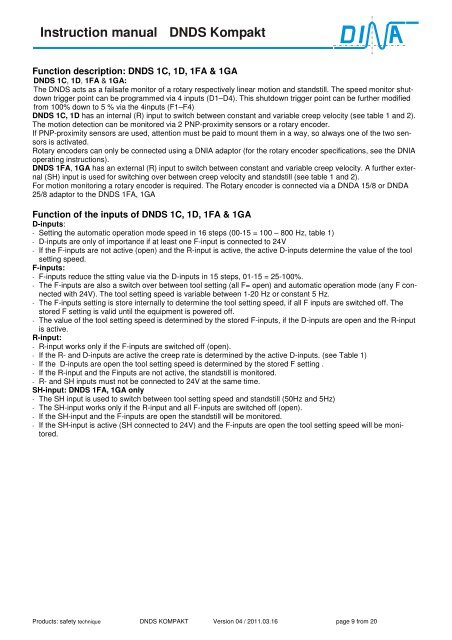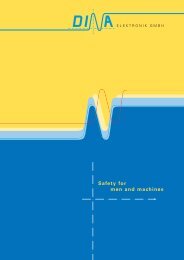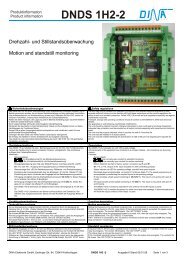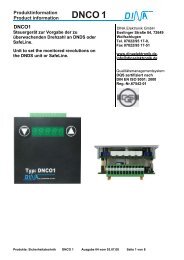Instruction manual DNDS Kompakt - Dinaelektronik.com
Instruction manual DNDS Kompakt - Dinaelektronik.com
Instruction manual DNDS Kompakt - Dinaelektronik.com
You also want an ePaper? Increase the reach of your titles
YUMPU automatically turns print PDFs into web optimized ePapers that Google loves.
<strong>Instruction</strong> <strong>manual</strong> <strong>DNDS</strong> <strong>Kompakt</strong><br />
Function description: <strong>DNDS</strong> 1C, 1D, 1FA & 1GA<br />
<strong>DNDS</strong> 1C, 1D, 1FA & 1GA:<br />
The <strong>DNDS</strong> acts as a failsafe monitor of a rotary respectively linear motion and standstill. The speed monitor shutdown<br />
trigger point can be programmed via 4 inputs (D1–D4). This shutdown trigger point can be further modified<br />
from 100% down to 5 % via the 4inputs (F1–F4)<br />
<strong>DNDS</strong> 1C, 1D has an internal (R) input to switch between constant and variable creep velocity (see table 1 and 2).<br />
The motion detection can be monitored via 2 PNP-proximity sensors or a rotary encoder.<br />
If PNP-proximity sensors are used, attention must be paid to mount them in a way, so always one of the two sensors<br />
is activated.<br />
Rotary encoders can only be connected using a DNIA adaptor (for the rotary encoder specifications, see the DNIA<br />
operating instructions).<br />
<strong>DNDS</strong> 1FA, 1GA has an external (R) input to switch between constant and variable creep velocity. A further external<br />
(SH) input is used for switching over between creep velocity and standstill (see table 1 and 2).<br />
For motion monitoring a rotary encoder is required. The Rotary encoder is connected via a DNDA 15/8 or DNDA<br />
25/8 adaptor to the <strong>DNDS</strong> 1FA, 1GA<br />
Function of the inputs of <strong>DNDS</strong> 1C, 1D, 1FA & 1GA<br />
D-inputs:<br />
- Setting the automatic operation mode speed in 16 steps (00-15 = 100 – 800 Hz, table 1)<br />
- D-inputs are only of importance if at least one F-input is connected to 24V<br />
- If the F-inputs are not active (open) and the R-input is active, the active D-inputs determine the value of the tool<br />
setting speed.<br />
F-inputs:<br />
- F-inputs reduce the stting value via the D-inputs in 15 steps, 01-15 = 25-100%.<br />
- The F-inputs are also a switch over between tool setting (all F= open) and automatic operation mode (any F connected<br />
with 24V). The tool setting speed is variable between 1-20 Hz or constant 5 Hz.<br />
- The F-inputs setting is store internally to determine the tool setting speed, if all F inputs are switched off. The<br />
stored F setting is valid until the equipment is powered off.<br />
- The value of the tool setting speed is determined by the stored F-inputs, if the D-inputs are open and the R-input<br />
is active.<br />
R-input:<br />
- R-input works only if the F-inputs are switched off (open).<br />
- If the R- and D-inputs are active the creep rate is determined by the active D-inputs. (see Table 1)<br />
- If the D-inputs are open the tool setting speed is determined by the stored F setting .<br />
- If the R-input and the Finputs are not active, the standstill is monitored.<br />
- R- and SH inputs must not be connected to 24V at the same time.<br />
SH-input: <strong>DNDS</strong> 1FA, 1GA only<br />
- The SH input is used to switch between tool setting speed and standstill (50Hz and 5Hz)<br />
- The SH-input works only if the R-input and all F-inputs are switched off (open).<br />
- If the SH-input and the F-inputs are open the standstill will be monitored.<br />
- If the SH-input is active (SH connected to 24V) and the F-inputs are open the tool setting speed will be monitored.<br />
Products: safety technique <strong>DNDS</strong> KOMPAKT Version 04 / 2011.03.16 page 9 from 20









